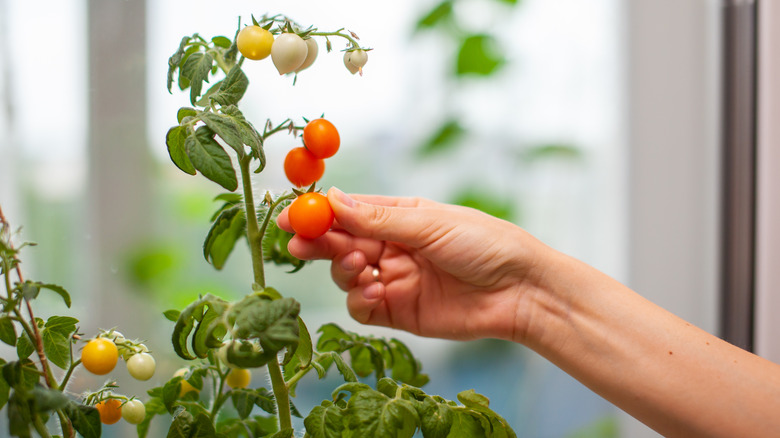The Best Tomato Varieties To Grow In Cooler Climates
If you live in a cooler climate, you might see growing tomatoes as a challenge. But don't lose hope—certain varieties like Oregon Spring, Northern Lights, Legend, Siberian, and San Francisco Fog defy conventional wisdom by thriving in chillier temperatures. These cool-weather-friendly types have distinct features that make them ideal for growing in less-than-perfect conditions. But why does the weather matter so much for tomato growing, and how does the sun come into play? Well, the sun works wonders for tomatoes, enhancing their flavor by powering the essential plant process of photosynthesis. The more sunlight your tomatoes receive, the more complex their flavor becomes.
In cooler climates, sunny days are often in short supply, putting a damper on photosynthesis. However, the specialized varieties mentioned rise above these limitations. Specifically bred to withstand colder temperatures and less frequent sunny days, they come with a shorter growing season and better tolerance for cold. This adaptability ensures that you can still look forward to a fruitful tomato harvest even if your local weather includes more fog, rain, or early frosts than the blazing sun. And the advantage? They still taste great. The takeaway: cooler climates shouldn't deter you from your tomato-growing ambitions. Adapt to your environment rather than fighting against it by choosing the right varieties.
Getting acquainted with cool-climate tomatoes
Let's delve into the distinctive characteristics of these five varieties suitable for cooler climates. The Legend tomato from Oregon boasts resistance to late blight, a significant advantage for those dealing with more humid and cool conditions. You can expect to harvest large, juicy fruits that are ideal for slicing in just about 60 to 70 days, making this an excellent choice for short growing seasons. Oregon Spring is another gem from the Pacific Northwest. This variety's ability to produce fruit without pollination, a feature known as parthenocarpy, makes it unique. It reaches maturity in as little as 60 days, distinguishing it as a convenient option for those dealing with an abbreviated growing period.
Then we have the Siberian tomato, aptly named for its place of origin. This variety excels at setting fruit even when temperatures are not exactly tropical. For those looking for a quick harvest, the Siberian matures in about 50 days, allowing you to enjoy its produce even when summer seems fleeting. Northern Lights, a product of the colder regions of the Northern United States, catches the eye with its unique bicolor fruits, blending shades of red and yellow. It's visually appealing and a relatively quick grower, taking about 55 days to mature. Lastly, the San Francisco Fog is tailored for climates that often experience misty, cool days. This variety adapts well to cooler temperatures and matures in about 70 days.
Cool-weather tomato growing tips: indoors or in a greenhouse
Even if you've chosen the most cold-tolerant tomato varieties, sometimes the climate or season still doesn't cooperate. By taking your tomato cultivation indoors, you control the variables that Mother Nature usually dictates, providing a more stable environment for your plants to thrive. Ensure you have a bright light source, whether it's a sunny window or specialized grow lights. Aim for at least 18 to 22 hours of direct sunlight or its artificial equivalent for seedlings. Next, consider the size of the pot for transplanting. Tomatoes aren't minimalists; they appreciate space for their roots to spread. When they reach 15 cm tall, transplant them to a pot that is at least 35 cm wide and 50 cm deep. The additional space gives the roots room to grow and retains moisture better.
Temperature is another critical factor. While these varieties are more forgiving of cooler conditions, they still need a temperature of around 70 to 80 degrees, except for the Siberian, which prefers much lower temperatures. Pollination is usually an automatic process outdoors, thanks to wind and insects. Indoors, you'll need to gently shake your tomato plants to help distribute the pollen. Regular fertilization is essential to provide your tomatoes with the nutrients they need, and it also helps manage your watering routine. Aim to keep the plants moist but not wet. Use your finger to test the soil; if it's dry an inch below the surface, it's time to water.


